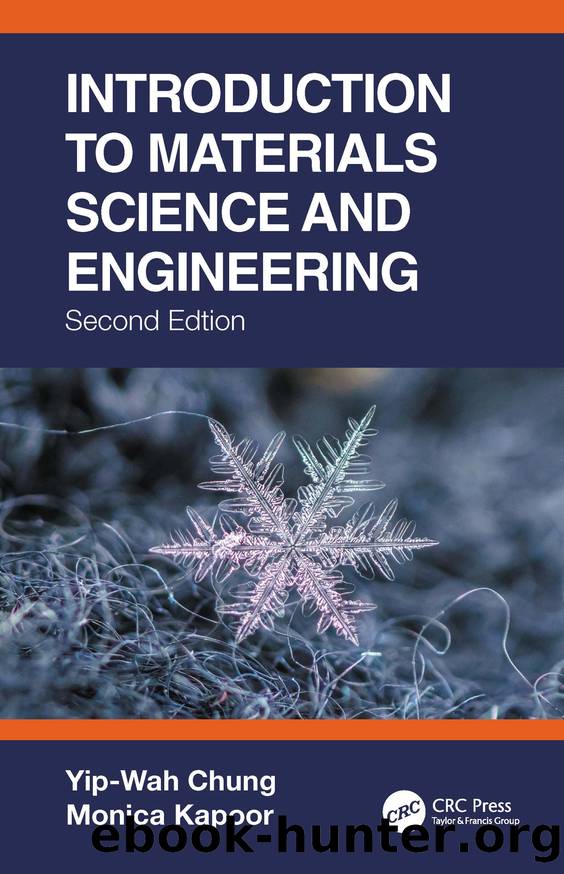Introduction to Materials Science and Engineering by Chung Yip-Wah;Kapoor Monica;

Author:Chung, Yip-Wah;Kapoor, Monica;
Language: eng
Format: epub
Publisher: Taylor & Francis Group
Published: 2022-02-17T00:00:00+00:00
At this point, you may wish to go outdoors. Throw both Frisbees to a height of about 3âm. What do you find (Figure 6.1)? What has this to do with ceramics? Why are these findings significant?
FIGURE 6.1 Two ice Frisbees, one with embedded paper strips and one without, before and after being dropped from 3âm. Before we get back to these questions, let us define what ceramic materials are. Traditionally, ceramics are materials that come out of clay after high-temperature firing: china, porcelain, tiles, bricks, and glassware (keramikosâ=âburnt material). Today, we consider ceramics to be the general class of inorganic nonmetallic compounds (semiconductors excluded). Usually, a ceramic compound consists of at least one metallic element and one nonmetallic element. Such ceramics are partially ionic. As we will see later, this has a large effect on electrical and mechanical properties of ceramics.
Returning to the ice Frisbee experiment, we can consider water (hydrogen oxide) to be a special case of an oxide ceramic. The Frisbee-throwing experiment resulted in the pure oxide ceramic breaking into pieces upon the first throw (Figure 6.1). This is not surprising since we learn in an earlier chapter that ceramics tend to have lower fracture toughness and hence fail more easily with sudden impact. On the other hand, the paper-impregnated oxide ceramic can withstand multiple throws without failure. How is it possible that something as fragile as paper can impart such dramatic performance improvement to this oxide ceramic? This is a classic case of a composite material that retains the strength of the matrix but with markedly improved fracture toughness. We will discuss this point further in a later section. It is left as an exercise for the readers to determine what happens when we change the amount of paper, or replace it with metal paper clips, or little pieces of rubber bands.
Download
This site does not store any files on its server. We only index and link to content provided by other sites. Please contact the content providers to delete copyright contents if any and email us, we'll remove relevant links or contents immediately.
Whiskies Galore by Ian Buxton(41675)
Introduction to Aircraft Design (Cambridge Aerospace Series) by John P. Fielding(32986)
Small Unmanned Fixed-wing Aircraft Design by Andrew J. Keane Andras Sobester James P. Scanlan & András Sóbester & James P. Scanlan(32655)
Craft Beer for the Homebrewer by Michael Agnew(18042)
Turbulence by E. J. Noyes(7853)
The Complete Stick Figure Physics Tutorials by Allen Sarah(7229)
Kaplan MCAT General Chemistry Review by Kaplan(6763)
The Thirst by Nesbo Jo(6682)
Bad Blood by John Carreyrou(6431)
Modelling of Convective Heat and Mass Transfer in Rotating Flows by Igor V. Shevchuk(6325)
Learning SQL by Alan Beaulieu(6129)
Weapons of Math Destruction by Cathy O'Neil(6034)
Man-made Catastrophes and Risk Information Concealment by Dmitry Chernov & Didier Sornette(5837)
Digital Minimalism by Cal Newport;(5547)
Life 3.0: Being Human in the Age of Artificial Intelligence by Tegmark Max(5352)
iGen by Jean M. Twenge(5268)
Secrets of Antigravity Propulsion: Tesla, UFOs, and Classified Aerospace Technology by Ph.D. Paul A. Laviolette(5199)
Design of Trajectory Optimization Approach for Space Maneuver Vehicle Skip Entry Problems by Runqi Chai & Al Savvaris & Antonios Tsourdos & Senchun Chai(4928)
Electronic Devices & Circuits by Jacob Millman & Christos C. Halkias(4835)
